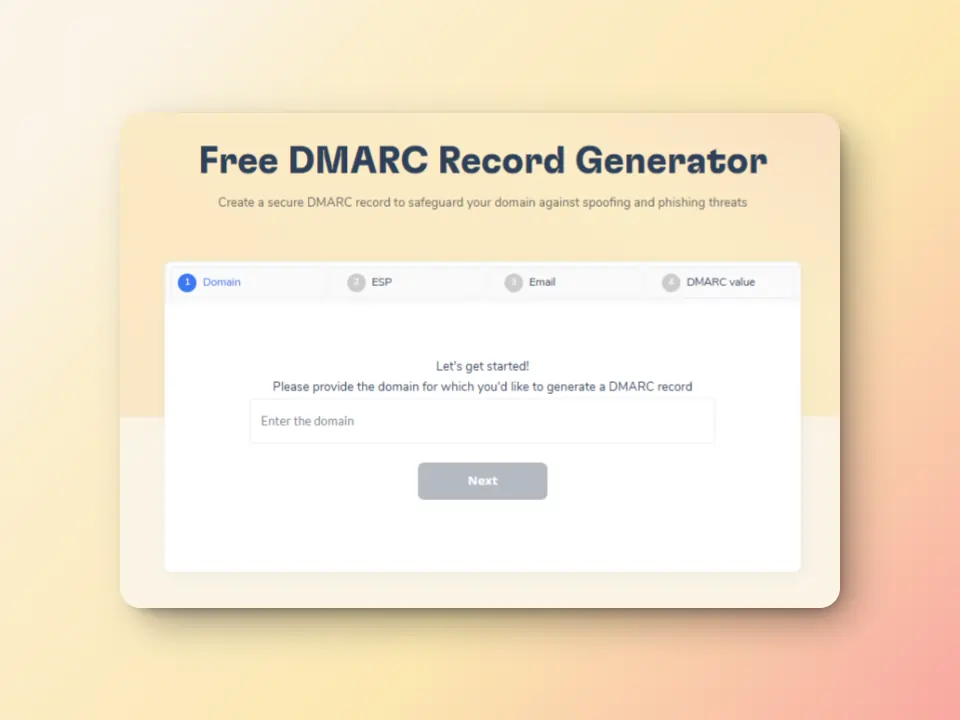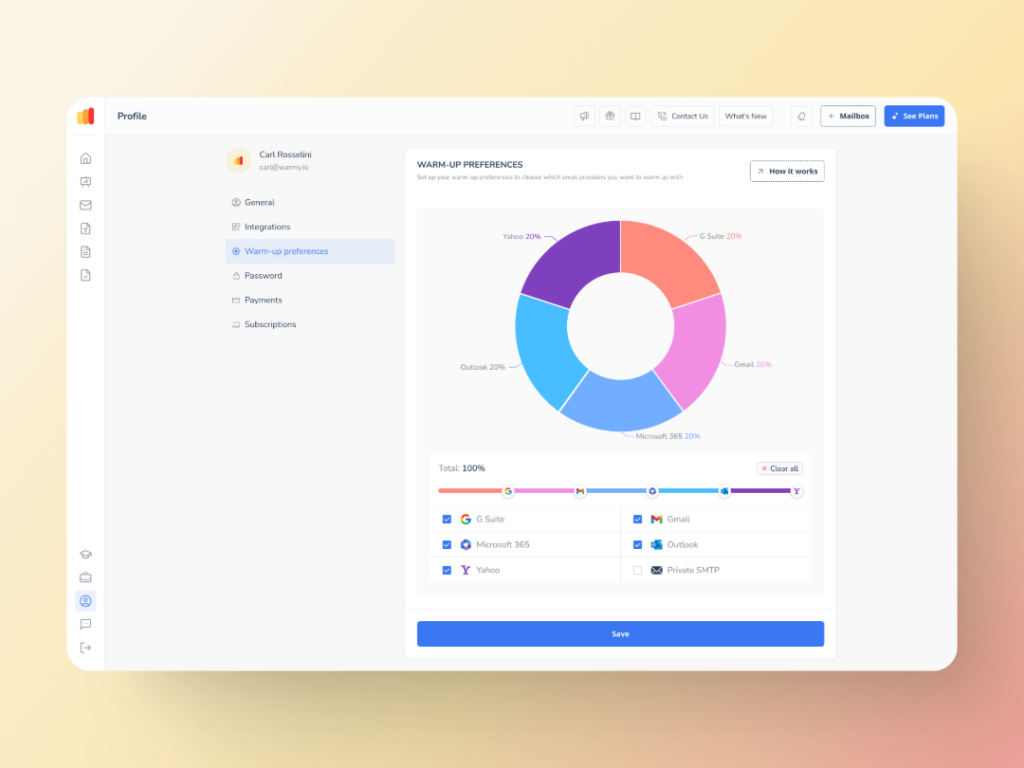If your means of business communications includes emails, it is important to secure your domain from bad actors. DMARC (Domain-based Message Authentication, Reporting & Conformance) is a really helpful feature that you can use to avoid having your email spoofed by attackers and used for sending phishing emails. It also makes you more likely to land in your customers’ inboxes than spam folders.
But DMARC can be a pain to set up. Particularly if you don’t have a technical or web design background. Plenty of small business owners, marketers, and entrepreneurs are scared of the jargon, coding, and potential mistakes that could throw them off track.
This guide changes that. We’ll demonstrate how you can get up and running with DMARC record in only five minutes with the help of a user-friendly DMARC generator tool. No coding skills required. By taking a few simple steps, your email domain will be secure, your brand will be safe from harm, and your emails will find safe passage to the recipient’s inbox—with no time lost to stress or misunderstandings.
Ready to get started? Let’s demystify DMARC and make your email safer today.
What is DMARC? A simple explanation
In Q4 of 2024, there were over 989,000 unique phishing attacks across the globe. This translates to major breaches—in fact, the average cost of a data breach against a company can go over $4 million.
Spoofing occurs when attackers send emails that appear to come from your business. Phishing employs these forged emails to provoke your customers into divulging sensitive info. Implementing DMARC weeds out these phony emails and prevents them from reaching your customers’ inboxes—keeping your brand and your customers safe.
DMARC (Domain-based Message Authentication, Reporting & Conformance) is a protocol that authenticates legitimate emails by confirming that they’re coming from your domain. It looks to see that messages are coming from authorized places and tells email providers what to do if a message doesn’t pass these checks—whether it’s marking the message as spam or not delivering it at all.
🔖 Related Reading: Don’t Let Your Emails Get Spoofed: How a DMARC Generator Helps
Why you should set up a DMARC record today
Enable DMARC record for your domain and it will be one of the smartest moves you can make to protect your business and improve your email success. Here’s why it matters:
Protect your brand reputation
Your brand is valuable. Without a DMARC record, your brand is vulnerable. When scammers send fake emails pretending to be you, it damages trust and can hurt your relationship with customers. DMARC results help stop these attacks, keeping your brand safe and your communications professional.
Improve email deliverability and inbox placement
Email services like Gmail, Outlook, Microsoft 365, and the rest verify your messages with DMARC records. If DMARC (and DKIM and SPF) is correctly configured, it’s more likely that your emails will land in someone’s inbox, instead of the spam folder, thus helping you to get your message in the target inbox.
🔖 Related Reading: SPF, DKIM, and DMARC: Boosting Email Security and Deliverability
Gain visibility with DMARC reports
DMARC generates reports that show who is sending emails from your domain. These insights help you spot unauthorized senders and make informed adjustments to your email setup.
Comply with industry standards and avoid blacklists
Many email services now expect domains to have DMARC configured. Without DMARC record in DNS, your emails risk being blocked or your domain blacklisted. Setting up DMARC, SPF, and DKIM keeps you compliant and your email flowing without interruptions.
🔖 Related Reading: Mastering Email Deliverability: The Modern Guide to Authentication and Inbox Warm-Up is a report from the Warmy Research Team that explores the intersection of authentication protocols such as DMARC, SPF, or DKIM records and the email warm-up process.
Common barriers to setting up DMARC
Even though DMARC is essential for email security, many small business owners and marketers hesitate to set it up. It’s not uncommon for this to be the case because the process appears complicated.
Technical jargon and complexity
Setting up DMARC involves difficult-sounding terms such as DNS records, DMARC alignment, SPF, DKIM, and policies, which are enough to drive you crazy if you’re not a techno-whiz. This can be so complex that it turns many potential senders off.
Example: You might see instructions telling you to “add a TXT record to your DNS with specific syntax,” which can feel like learning a new language. But tools like Warmy.io’s DMARC generator simplify this by creating the correct DMARC record tags for you, no coding needed.
Fear of breaking email systems
Many worry that if they misconfigure DMARC, their legitimate emails might stop working or get blocked. This fear of disrupting business communications often causes delays.
Example: Imagine sending important newsletters or client emails and suddenly they stop arriving. That’s why starting with a “none” policy (which monitors without blocking) lets you test your setup safely before enforcing stricter rules for DMARC failures.
Lack of time or IT resources
Small businesses may not have IT staff to handle email security. After all, busy owners and marketers probably delay DMARC implementation because they believe they have neither the time nor expertise, right?
Example: Using a DMARC generator tool saves you time by guiding you step-by-step through the setup. You don’t need to wait for an IT appointment. You can do it yourself in minutes.
How a DMARC generator tool simplifies setup
A DMARC generator makes it easy to create a DMARC record and an accurate DNS TXT record without errors. It formats the record automatically according to your settings and authentication needs—preventing the errors that humans normally make when they have to manually add all the tags.
This can be daunting (perhaps even frightening) to small business owners and marketers with limited technical skills. But with DMARC generator, anyone (even someone without IT skills) can secure their email domain with confidence, using the simple, intuitive, step-by-step user friendly interface.
Step-by-step guide: setting up DMARC in 5 minutes with Warmy

Implementing DMARC doesn’t need to be hard or time-consuming. Do it easily with Warmy’s DMARC generator, and you’ll protect your email domain in minutes. No technical expertise necessary.
Step 1: Access the Warmy.io DMARC Generator
Visit Warmy.io and navigate to our DMARC generator page. This tool is designed to guide you through the setup with an easy-to-use interface, no confusing code or jargon. You’ll be able to create DMARC records right away.
Step 2: Enter your domain details
Type in the domain name you want to protect. For example, if your email is sales@yourbusiness.com, enter “yourbusiness.com.” This tells the tool which domain you want to create the DMARC record for.
Step 3: Choose your DMARC policy (none, quarantine, reject) explained
Select the policy or DMARC instructions you want to apply to your domain:
- None: This policy monitors your emails without blocking anything. It’s a safe starting point to gather data without affecting delivery.
- Quarantine: If the email fails DMARC check, suspicious emails are sent to the recipient’s spam or junk folder. This adds protection while being cautious.
- Reject: This policy blocks emails that fail the DMARC checks outright, offering the highest level of security. Use this only after you’re confident your setup is correct.
Step 4: Configure reporting options (Optional)
You can choose to receive DMARC reports that show you how your domain is being used. Enter an email address where you want to get these reports. This step is optional but highly recommended for ongoing monitoring.
Step 5: Generate your new DMARC record
Click the button to generate your DMARC DNS TXT record. Warmy.io will create the exact record you need, formatted correctly. Get the DMARC and you can proceed to add your DMARC record in your DNS settings.
Step 6: Add the generated DMARC record to your DNS settings
Log into your domain registrar or DNS hosting provider. Find the section for DNS management and add a new TXT record. Paste the DMARC by adding it into the value field. Set the record name as _dmarc.yourdomain.com (replace “yourdomain.com” with your actual domain).
Step 7: Verify your DMARC setup
After adding the record, use Warmy.io’s verification tool or other online DMARC checkers to confirm your record is live and correctly configured. It may take a few hours for DNS changes to propagate, so check back if it doesn’t show immediately.
Frequently Asked Questions (FAQs) about DMARC setup
Will setting up DMARC affect my email delivery?
When set up correctly, DMARC improves your email delivery by helping providers recognize your messages as legitimate. Starting with a “none” policy lets you monitor without impacting delivery. As you fine-tune your setup, you can move to stricter policies without disrupting your emails.
What happens if I misconfigure DMARC data?
A misconfigured DMARC record can cause your legitimate emails to be marked as spam or rejected. That’s why it’s important to start with a monitoring policy (“none”) and use a DMARC generator tool like Warmy.io to create error-free records. Always verify your setup before applying stricter policies.
Can I use DMARC together with other email authentication protocols?
Yes! DMARC is complementary to SPF (Sender Policy Framework) and DKIM (DomainKeys Identified Mail). Combined, these protocols improve your email security, and help verify to an email provider that your messages are indeed yours and that they are safe.
🔖 Related Reading: SPF, DKIM, and DMARC: What They Are and Why You Should Care
How often should I check and monitor DMARC reports?
It’s best to manage DMARC reports regularly and consistently monitor the DMARC results. At least once a week or month depending on your email volume. These reports help you spot unauthorized senders, track email delivery, and adjust your policies to keep your domain secure.
How Warmy helps maximize deliverability aside from the DMARC Generator
Even though creating DMARC policies is an essential step to keep your domain safe from email spoofing, getting your emails to reach the inbox really depends on a combination of other factors—and it is for the most part an ongoing process.
SPF Record Generator

Warmy’s SPF Record Generator allows you to make accurate SPF records in an easy and very quick way, even without deep technical knowledge. You just need to click a few times, and you get a properly formatted SPF TXT record ready to add to your DNS. This tool makes it easier to avoid common mistakes like typos in your syntax or exceeding DNS lookup limits, which can cause authentication failures. Proper SPF setup works hand-in-hand with DMARC deployment to prevent domain spoofing and improve email trust.
AI-powered email warmup

Building a strong sender reputation takes time and consistent positive engagement. DMARC policies help, but warming up your email domain properly is crucial to inbox placement. Warmy’s AI-driven email warmup gradually increases your sending volume while simulating real, authentic interactions with genuine inboxes. This natural warming process signals to email providers that your domain is trustworthy, greatly reducing the chance your emails end up in spam. The AI continuously monitors your mailbox health and adapts sending patterns to keep the warmup safe and effective.
With Warmy’s Warmup Preferences, you can tailor how warmup emails distribute across different email providers and choose between B2B or B2C engagement styles to best fit your needs.
Advanced seed lists

Warmy provides advanced seed lists containing real email addresses from various providers. Sending your campaigns to these seed addresses allows you to track inbox placement and detect deliverability issues before your actual recipients do. These seed accounts behave like real users—they open, read, scroll, and click—boosting your sender reputation. If any emails are incorrectly flagged as spam, they’re identified and removed to keep the seed list clean and reliable.
Say goodbye to spoofing and build trust with Warmy.io
Email spoofing is more common than you might think—and it can seriously harm your brand reputation, customer trust, and email deliverability. Add DMARC to your warmup strategy as it is a crucial defense to ensure only authorized emails reach your audience.
Warmy’s DMARC generator, combined with its complete suite of deliverability tools, provides the all-in-one solution that modern email marketers need. Don’t leave your brand vulnerable. Start securing your emails today with Warmy and enjoy the peace of mind that comes with stronger email authentication.
Sign up now and take control of your email deliverability with Warmy.io.











